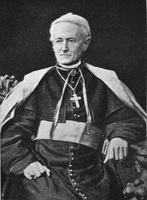 | Back to e-WV
| Back to e-WV
 The West Virginia Encyclopedia
The West Virginia Encyclopedia
 | Back to e-WV
| Back to e-WV
 The West Virginia Encyclopedia
The West Virginia Encyclopedia

The first significant Catholic presence in Western Virginia came in the years immediately following the American Revolution, when Virginia repealed its anti-Catholic laws. Small Catholic communities soon formed in what is now the Eastern Panhandle and in Wheeling.
A turning point came with the arrival of the Baltimore & Ohio Railroad in the mid-1840s. The railroad employed many laborers, some of whom were Catholic Irish immigrants who would settle in the region. Up until that time, the Catholics of Western Virginia had been under the spiritual care of the Diocese of Richmond, which represented the entire state of Virginia. Encouraged by the increase in the number of Catholics in the west, the bishop of Richmond, Richard V. Whelan, petitioned Rome to create a new diocese. On July 19, 1850, Pope Pius IX established the Diocese of Wheeling, naming Whelan as its first bishop.
The Allegheny Mountains were used as the initial boundary of the new diocese. The outbreak of the Civil War and the creation of the new state of West Virginia in 1863 meant that diocesan and state boundaries would be distinct from one another for more than 100 years. It was not until 1974, under a decree issued by Pope Paul VI, that the diocesan borders were realigned to agree with those of the state. The name of the diocese was changed at that time to the Diocese of Wheeling-Charleston.
The most important period of growth in the Catholic population was in the second half of the 19th century, when West Virginia began to industrialize. Bishop John J. Kain (1875–93), who succeeded Whelan, served during this period. Immigrant Catholics came to work in the mines and factories, the ethnic groups arriving in successive waves. In the first part of the 19th century, immigration was dominated by the Irish and Germans. By the end of the century, immigrants from southern, central, and eastern Europe began to make up a substantial percentage of the state’s Catholic population.
Rt. Rev. Patrick J. Donahue (1894–1922) was bishop of the Diocese of Wheeling during a continuing period of tremendous growth. In the 28 years he served, the Catholic population more than tripled, from approximately 20,000 when he was appointed in 1894 to more than 62,000 at his death in 1922. Donahue approved the establishment of nearly 150 churches and missions during his years as bishop and encouraged the founding of schools, hospitals, and orphanages.
Bishop Donahue was succeeded by John J. Swint, who served from 1922 to 1962. Bishop Swint came to office during a period sometimes referred to as ‘‘bricks-and- mortar Catholicism.’’ The great wave of immigration was past, and attention turned from meeting the immediate needs of arriving immigrants to establishing the institutions to serve them and their children. At his death, close to 100 churches, a new cathedral, one college, 43 elementary and high schools, and five hospitals had been established under Bishop Swint’s leadership.
Bishop Joseph H. Hodges (1962–85) succeeded Swint as the fifth bishop of the diocese. Bishop Hodges represented the diocese at the Second Vatican Council (1962–65). He dedicated his years as bishop to implementing the modernizing reforms of the council.
The successor to Hodges was Bishop Francis B. Schulte, who had been auxiliary bishop of the Archdiocese of Philadelphia. Evangelization was an important priority for Bishop Schulte. Schulte was succeeded by Bernard W. Schmitt in 1989. As he attended to issues of spiritual vitality, religious education, and social issues, Bishop Schmitt also addressed the staffing of parishes and missions as the number of clergy declined.
Schmitt was succeeded by Michael J. Bransfield in 2005. Upon turning 75, Bransfield submitted his resignation in September 2018. Baltimore archbishop William Lori was named temporary administrator of the diocese and instructed to investigate allegations of sexual harassment against Bransfield. On March 19, 2019, Attorney General Patrick Morrisey sued the Diocese of Wheeling-Charleston and Bransfield, claiming they knowingly employed admitted sexual abusers, hired priests credibly accused of sexually abusing children, and hired priests and lay employees without performing adequate background checks. On July 23, Pope Francis named Baltimore Auxiliary Bishop Mark Brennan to lead the Wheeling-Charleston diocese.
After more than 100 years of growth, West Virginia’s Roman Catholic population peaked in the mid-20th century but has declined since that time. While exact numbers are hard to find, it appears that there were something over 110,000 Catholics in 1960 and about 100,000 in 2000. By 2022, that number had dropped to less than 67,000.
Today, the Diocese of Wheeling-Charleston, made up of 92 parishes, is the second-largest provider of social services in the state, operating programs that range from emergency relief to parenting classes. The Catholic school system, which includes Wheeling University, 24 elementary and high schools, and preschool and day care programs, is the largest privately run school system in West Virginia. It also operates the Promise House Family Resource Center for low-income families in the Martinsburg area. From Wheeling Hospital (now affiliated with WVU Medicine), in the Northern Panhandle, recognized as the first hospital founded in West Virginia, to the Pineville Children’s Center in the southern coalfields, the Catholic health care system has served the state’s citizens for the past 150 years.
Written by Tricia Pyne
Diocese of Wheeling-Charleston. Diocesan Statistics, 2022.